In the Church calendar, today July 29, we commemorate Saint Olaf, and next Monday August 1 we honor the Seven Maccabean Brothers.
Saint Olaf of Norway
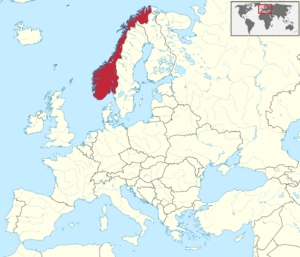 we count him as Western Orthodox – “far northwestern Orthodox”, as people knew the world in those days.
we count him as Western Orthodox – “far northwestern Orthodox”, as people knew the world in those days.As for Saint Olaf, the more I read about him, the more confused I got, and the less I wished I had promised to write about him. (Various sources contradicted each other about the details, and I seemed to run into Olafs and Olofs and Olaves and Olavs all over the place.) Nevertheless I promised. I’m not on my home turf here, so if any of you spot errors, please let me know.
Here’s Orthodox Wiki’s quick summary of his life:
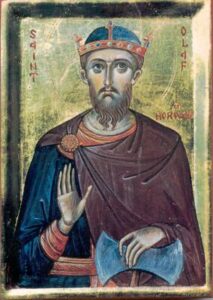 “The holy, glorious, right-victorious martyr and right-believing King Olaf II of Norway (sometimes spelled Olav) is also known as Olaf Haraldson and was a son of Earl Harald Grenske of Norway. During his lifetime he was also called Olaf the Fat. He was born in 995 A.D., and ruled Norway from 1015 to 1028, when he was exiled. He died two years later on the field of battle at Stiklestad, killed for his support of the Christian faith and his attempt to unite Norway into one nation. * His feast day is July 29. He should not be confused with his predecessor Olaf Tryggvason (King Olaf I of Norway)”.
“The holy, glorious, right-victorious martyr and right-believing King Olaf II of Norway (sometimes spelled Olav) is also known as Olaf Haraldson and was a son of Earl Harald Grenske of Norway. During his lifetime he was also called Olaf the Fat. He was born in 995 A.D., and ruled Norway from 1015 to 1028, when he was exiled. He died two years later on the field of battle at Stiklestad, killed for his support of the Christian faith and his attempt to unite Norway into one nation. * His feast day is July 29. He should not be confused with his predecessor Olaf Tryggvason (King Olaf I of Norway)”.
- It was said that his last words before he died were “God help me”.
What we know of his life came from the pen of Snorri Sturluson, a 12th and 13th century Icelandic historian. In his youth Olaf took part in Viking pirate raids into England. Vikings were unsettled men from the Scandinavian countries who raided France and Britain. Some were so fierce (as I was told in Anglican seminary) that British along the coasts added a petition to their Litany begging God to protect them “from the fury of the Norsemen”.
Other Vikings were just adventurers seeking their fortune. Olaf apparently was one of these, for in England he first came into contact with Christianity and was drawn to it. It’s not altogether clear why he went to Normandy (in northern France) where he was baptized. He then returned to Norway and, with much difficulty and in many battles, finally united the tribes and was proclaimed King.
Just in passing, Olaf’s private life was confusing to say the least. This is from Wikipedia: “He made peace with King Olof Skötkonung of Sweden through Þorgnýr the Lawspeaker, and was for some time engaged to Olof’s daughter, Ingegerd, though without Olof’s approval. In 1019 Olaf married Astrid Olofsdotter, King Olof’s illegitimate daughter and the half-sister of his former fiancée.” * You’ll hear more about the family later.
- Got that?
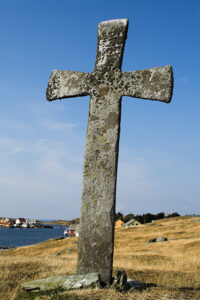 Old stone crosses and other Christian symbols along the coast of Norway give evidence of an earlier Christian presence in the land. However as King, Olaf made it his purpose to bring all Norway to the Christian Faith under his rule. He demolished pagan temples and built churches. He brought many bishops and priests from England. He established a legal code for the Church of Norway.
Old stone crosses and other Christian symbols along the coast of Norway give evidence of an earlier Christian presence in the land. However as King, Olaf made it his purpose to bring all Norway to the Christian Faith under his rule. He demolished pagan temples and built churches. He brought many bishops and priests from England. He established a legal code for the Church of Norway.
Roar Johansen (GNU Free Documentation License)
The Church in Norway was under the jurisdiction of the Pope of Rome, but it wasn’t till after Olaf’s time that Roman Catholic canon law (priestly celibacy, for example) became the norm.
Was the Norwegian Church Orthodox? Yes. That’s the only kind of Christianity that existed in the West at the time. The theological squabbles of Eastern Christianity were long gone (even if not entirely resolved), the Western break with Orthodoxy was still a few years in the future, and the Protestant rebellion wouldn’t come for five centuries.
King Olaf’s rule did not last very long, but his legacy has. It was Olaf’s illegitimate son Magnus the Good * who, with his, um, concubine Alvhid *, promoted the cult of his father. Churches were dedicated to him in many places, including Denmark which he then ruled.
- Whoops! or maybe this happened before Olaf became a Christian. Magnus the Good, on the other hand, was definitely a Christian, and apparently was not as “good” as he should have been.
Olaf was an unusual saint, granted – a warrior king – but those were very unsettled times out on the edge of known civilization.
Saint Olaf is today the patron of Norway and of the Faroe Islands to the north.
There are churches dedicated to Saint Olaf (or Olav or Olave) all over the world, chiefly Lutheran, but also Roman Catholic and Anglican. I’ve found a Saint Olave’s Church in Serampore, India, and a Saint Olaf Kirke in Cranfills Gap, Texas. (here)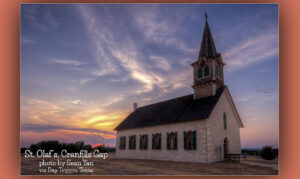
Today the Lutheran Church of Norway has about 3.7 million members, 69% of the Norwegian population. It is supported financially by the state, and each person’s tax money goes to the C of N, unless they choose to opt out.
Church attendance is more or less in line with that of the rest of western Europe – that is, poor, to put it mildly.
As of 2004, only about 12% of the members of the Church of Norway attended church as often as once a month. Saint Olaf, who gave his life and death for the sake of establishing Christianity in Norway, is not pleased.
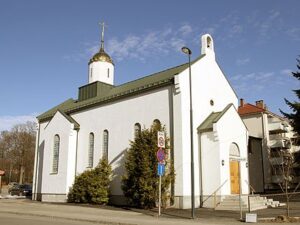 Oh, I almost forgot. There are some Eastern Orthodox in Norway: 11,205 official members in 2012, up from 2,315 in 2000. This is San Nikolai Church (Serbian) in Oslo.
Oh, I almost forgot. There are some Eastern Orthodox in Norway: 11,205 official members in 2012, up from 2,315 in 2000. This is San Nikolai Church (Serbian) in Oslo.
The Seven Holy Maccabean Martyrs
with their mother Solomonia and their teacher Eleazar
Now we’re back to the Bible, * so this will be easier to deal with.
- unless you’re a Protestant, whose Bibles no longer contain this book, though some place it in a separate section called “The Apocrypha” . (Why did the Protestants eliminate these books? Just ask, if you’re interested. Too much to talk about now.)
If I were you, I’d quit this Post now, and go to the book of Second Maccabees, chapters 5-7, and read the full story, which is better than the summary I’ll provide here.
_________________________________
This is a heartbreaking, tragic, but inspiring story of steadfastness in the Faith.
The seven Maccabean brothers were Abim, Antonius, Gurias, Eleazar, Eusebonus, Alimus and Marcellus. They with their mother Solomonia and their teacher Eleazar were martyred in the year 166 BC under the Syrian king Antiochus IV Epiphanes.
Here was the situation. The Holy Land had been conquered by the Greeks during the earlier campaign of Alexander the Great. Alexander died young. His empire was so huge that in order to govern it, it had been divided, each part ruled by a Greek king. One of these was Antiochius IV Epiphanes.
 GNU free documentation license
GNU free documentation license
You regular readers know I’m a Greekophile, so I’m glad to say that not all Greek rulers were like Antiochus. Alexander himself had been more than open to other religions – even took part in their practices himself.
But Antiochus was a rat, a tyrant. It was not surprising that he loved Hellenistic customs, but was that any reason for him to hold everything non-Greek in contempt? From Syria he ruled over Palestine, and he did everything he could to turn the Jews away from the Law of Moses, their covenant with God, and anything Jewish. Men could no longer be circumcised. People were forced to eat pork – or die. And just to make the point clearer, he placed a statue of the pagan god Zeus in the Holy of Holies of the Temple in Jerusalem and commanded the Jews to worship it. This was the “abomination of desolation” foreseen by the prophet Daniel. *
- And foreseen again by our Lord (e.g. Mark 14:13). At the time of the Roman invasion of Jerusalem in the year 71, Emperor Titus set up a pagan statue in the Temple, just before he leveled the place. Earlier about the year 39, Emperor Caligula wanted to place a statue of himself (who else?) in the temple, but the Jews protested, and then Caligula (to the relief of everyone, everywhere) died before it could be erected.
As is always the case, most people went along in order to get along. (Consider how the Middle East and Asia Minor, those great centers of Orthodox Christianity, went mostly Muslim.) This was also sadly true with most of the Jews. But there were holdouts who refused to abandon their Faith and their God.
Eleazar, a ninety year old elder, scribe and teacher would not submit. He was brought to trial, was tortured and died in Jerusalem.
And then there were his students and disciples, the seven Maccabean brothers. They were taken to Antioch for trial, where they confessed themselves to be followers of the One True God, and they refused to eat pig’s flesh when it was thrust upon them.
Icon with permission of Saint Isaac’s Skete, skete.com
The eldest brother spoke for the rest, saying that they would rather die than break the Law of God. In sight of his brothers and their mother, his tongue was cut out, he was scalped, and his hands and feet were cut off. Then a cauldron and a large frying pan were heated, and the first brother was thrown into the pan and was fried alive till he died.
The next five brothers were tortured one after the other. The seventh and youngest brother was the last one left alive. Antiochus asked Solomonia to persuade the boy to obey him, so that at least one of her sons would survive. Instead, she told him to follow the courage and faithfulness of his brothers. The child then upbraided the king and was tortured more cruelly than his brothers had been, and… [you don’t want to hear about it.]
Their mother Solomonia was last to die. She who had taught them, now followed them in their great courage. She had watched all of her seven sons die, one by one. She stood weeping over their bodies, raised up her hands in prayer to God and died. Lord have mercy.
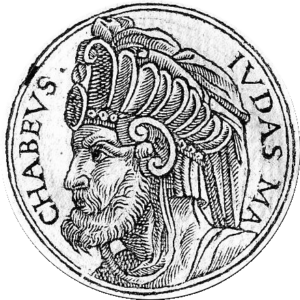 The story of the faith and steadfast courage and martyrdom of the Maccabean brothers, their teacher and their mother, was spread secretly among the Jews.
The story of the faith and steadfast courage and martyrdom of the Maccabean brothers, their teacher and their mother, was spread secretly among the Jews.
Imaginary depiction of Judas Maccabeus, 1553
It inspired Judas Maccabeus (son of a Hebrew priest who with his family had previously fled to the hills) who became a guerilla leader and led a revolt against Antiochus Epiphanes. Amazingly, with God’s help, he gained the victory, and drove the Greeks out of Palestine. He then purified the Temple at Jerusalem and threw down all the pagan altars and shrines in the land.
 Jews celebrate the Maccabean victory over Antiochus each year in the festival of Hannukah. Because of them an independent Jewish nation was established…
Jews celebrate the Maccabean victory over Antiochus each year in the festival of Hannukah. Because of them an independent Jewish nation was established…
Creative Commons license
…though only for about a century, till the Romans moved in. The Romans, however, were more tolerant of other peoples and their religious practices, so long as they behaved themselves and didn’t make trouble. (This was why the priests and pharisees later were so afraid that Jesus would lead a rebellion.)
So it was because of the Maccabees and their teacher and their mother – these nine brave people – that the Jewish Faith survived, so that a century and a half later Jesus Christ was able to come to His own believing people, who were eagerly awaiting their Messiah.
Sadly the Messiah they (and we) got was not the Messiah they wanted. But in light on their recent history, can we understand why the Jews were so eager for a warrior Messiah who would restore the Jewish nation?
A number of the Church Fathers (Saint Cyprian of Carthage, Saint Ambrose, Saint Gregory Nazianzus, Saint John Chrysostom, among them) preached sermons about the Maccabees, making this point, drawing this moral:
The bravery and steadfastness of only a few people can preserve the Faith and can change the course of history.
__________________________________________
The next two weeks: After over five years of Posting every week (with only one exception), I’m going to take a break. In anticipation of the great Feast of the Dormition, I’ll republish my two old Posts on “Why do we honor the Mother of God? Because the Bible says so!”
In three weeks a very personal Post: “As I begin my 85th year…”